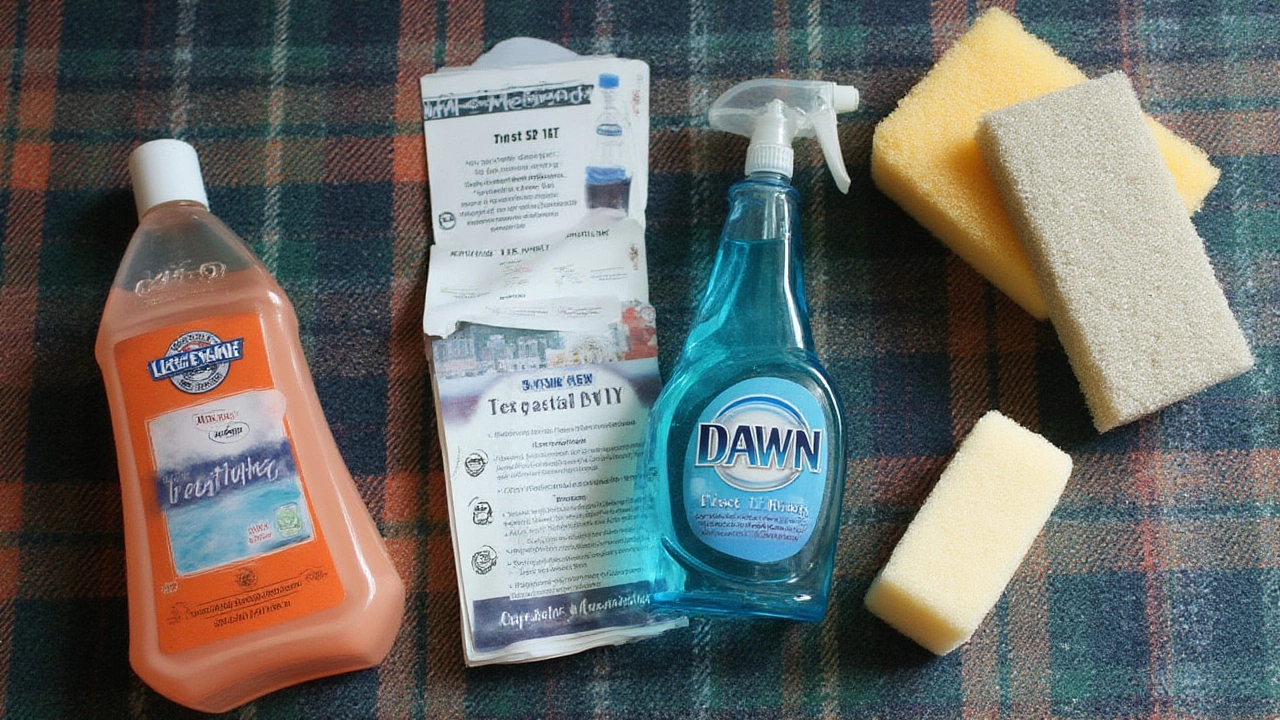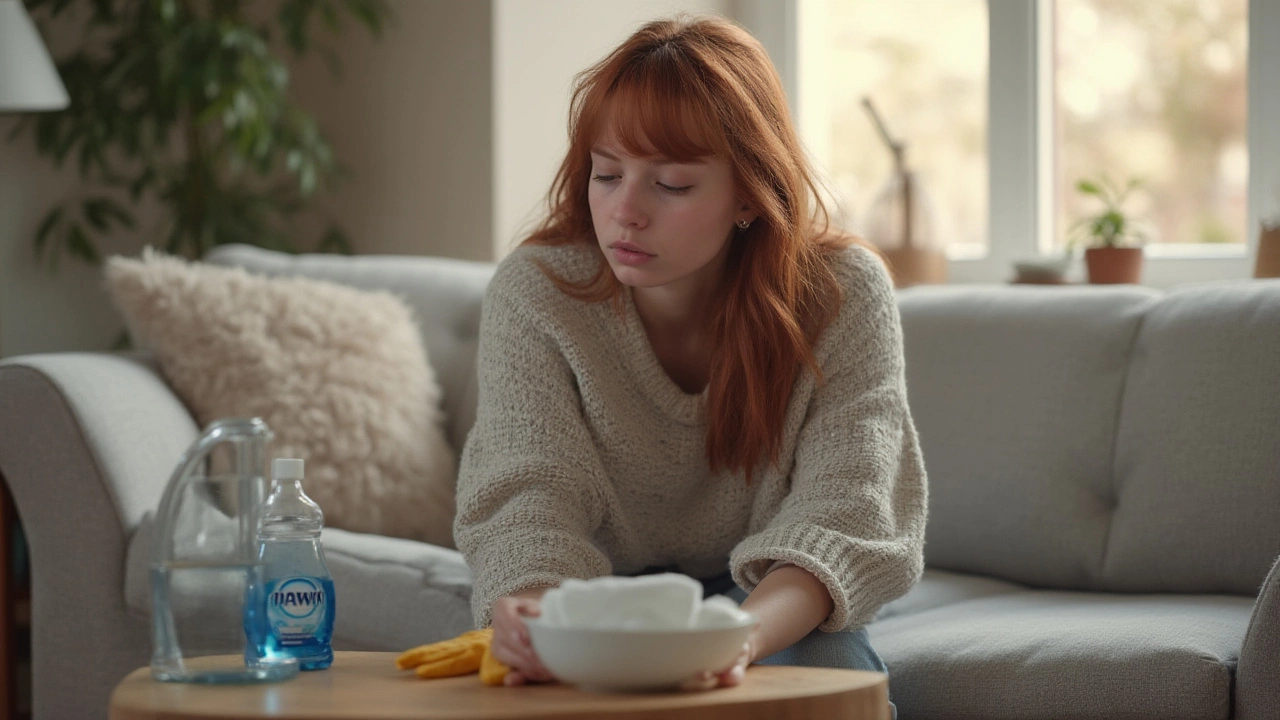If you’ve ever hit the panic button after spotting juice splatters or muddy paw prints on your sofa, you probably scrambled for the nearest bottle of Dawn. It sits on most kitchen sinks for greasy pans, but rumors say it’s a secret weapon for fabric too. But does it really work, or are you risking a soapy disaster on your upholstery? Turns out, there’s a lot to know before dousing your couch with the blue stuff. I’ve learned firsthand, thanks to Jasper’s sticky hands and Charlie’s love of muddy walks, that what works on dishes might not always make furniture better. Let’s pull back the curtain on Dawn dish soap and see what it actually does to your favorite chair.
What’s In Dawn, and Why Do People Use It on Upholstery?
Dawn isn’t just a dish soap—its formula packs a punch way beyond plates and pans. It’s made to break down greasy messes using surfactants that pull oily grime away from surfaces. That makes Dawn a superhero for bacon pans, but it’s also the same reason people reach for it when juice or salad dressing hits the armchair. If you dig into the label, you’ll see it contains cleaning agents, solvents, and stabilizers. Crucially, it’s free of phosphates. The makers regularly tout its safety and gentle formula, even highlighting how it’s used in wildlife rescue to clean oil-soaked animals. Procter & Gamble once stated:
“We’ve worked with wildlife responders for decades, making Dawn part of the rescue protocol because of its ability to tackle tough, oily messes without harming animals.”
People like using Dawn on fabric precisely because it’s known to cut through oil, but that doesn’t mean it’s foolproof. A quick squirt won’t melt chocolate pudding out of the cushions in seconds. What it actually does is help loosen tricky spots without relying on harsh solvents. But here’s where things get interesting—it isn’t marketed for sofas and chairs, so there are no directions for upholstery jobs on the bottle. That’s left a lot of room for DIY hacks and the endless parade of ‘miracle cleaning’ videos online. I’ll admit, I’ve been guilty of trying a few. When you see those dramatic stain-removal clips, remember, they can leave out the real-life mess behind the scenes. What people don’t always realize is that dish soaps like Dawn can leave behind residue, which attracts dirt later or even changes fabric color if you’re not careful.
But what actually happens when you try it? Most light-duty fabrics—think cotton blends, polyester, nylon—handle diluted Dawn pretty well. The key is the word ‘diluted.’ Nobody is slathering their microfiber loveseat with thick, blue goop straight from the bottle (unless you want to play a round of ‘Guess That Stain’ with your future self). The golden rule is always to mix just a few drops into a cup of water before touching the fabric. Some people even make a foamy solution by shaking it up in a spray bottle. More delicate fabrics, like velvet, wool, or silk? Don’t risk it. Always do a patch test somewhere hidden. I speak from experience—our old blue armchair still has a bleached-out patch on the back leg from where I learned that lesson the hard way. And if your sofa has a cleaning code ‘X’ on the tag, don’t mess with any water-based solution, including Dawn.
There’s a reason pros sometimes use Dawn in their upholstery shampoos—it’s cost-effective, widely available, and works for oily stains. But the catch is, they know how much to use, how to rinse, and how to dry the fabric quickly. At home, it’s easy to forget that furniture isn’t meant to stay damp, which can lead to musty smells or, worse, mildew. Bottom line: Dawn is a helper, but not a magic fix for every spill.
Is Dawn Better Than Store-Bought Upholstery Cleaners?
Stacking up Dawn against products made just for couches is like comparing a Swiss army knife to a toolbox—it’s useful for lots of small jobs, but sometimes you want a tool with just one purpose. Most upholstery cleaners have detergents meant for fabrics, along with deodorizers, anti-resoiling agents, and sometimes even enzymes that break down organic messes. You won’t find all that in a bottle of Dawn. The real question is, does Dawn do the job cheap and easy, or are you shortchanging your upholstery?
If you only have a small spot, like a ketchup blob from Jasper’s latest snack attack, then diluted Dawn can be nearly as good as specialty cleaners. Consumer Reports actually noted in a 2019 test that a basic soap-and-water solution beat some pricey sprays for removing simple food stains. But when it comes to cleaning a whole sofa, dish soap can be risky. Why? It isn’t designed to rinse out quickly from thick, absorbent cushions. Leftover soap can leave streaks or a sticky film that acts like a magnet for dust. If you don’t rinse carefully, you could end up needing to clean the same spot over and over.
Store-bought fabric cleaners have controlled pH levels and often contain things that help speed drying. They may also have optical brighteners or odor removers, which make fabrics look and smell fresh. Dawn, for all its strengths, just cleans—it doesn’t deodorize or brighten. And if you have pets like our loyal Charlie, who loves a good roll on the carpet after a rainstorm, that lingering wet-dog smell might stick around. So, is Dawn the best tool for keeping your loveseat looking fresh year after year? Probably not. Is it a handy emergency fix when you need it? Sure. Just don’t expect dish soap to do what specialized products can, especially for big or tricky jobs.
But there’s one place where Dawn shines: greasy stains. If you get pizza grease, oil from chips, or sunscreen on the fabric, Dawn stands out. Its formula is engineered for breaking oily bonds. Reputable cleaning companies sometimes list Dawn as a secret ingredient for these specific messes. But for wine, mud, blood, or ink stains, you’ll almost always get better, faster results with a cleaner designed for those types of grime. Overusing Dawn or getting the balance wrong means more work for yourself because soapy residue is a pain to fully remove from dense upholstery.
| Stain | Dawn Solution | Specialty Cleaner |
|---|---|---|
| Greasy Food | Very Effective | Effective |
| Red Wine | Somewhat Effective | Very Effective |
| Ink | Ineffective | Effective |
| Pet Urine | Limited | Very Effective |
| Chocolate | Effective | Effective |

How to Clean Upholstery with Dawn: Step-By-Step Tips
If you’re ready to try Dawn on your own sofa, a little prep work can save a lot of headaches later. Here’s how I do it, especially after an incident with chocolate ice cream on our beige sectional (Thanks, Jasper.):
- Test First: Find a hidden spot before you go all in. Dab your cleaning mix there and see if the color or texture changes after it dries.
- Mix Properly: Don’t pour straight from the bottle. Use one or two drops in a cup of lukewarm water. Swirl it up to get a little foam—the bubbles do the cleaning, not the liquid itself.
- Blot—Don’t Rub: Press a clean cloth into the stain. Rubbing spreads it around, especially on woven fabrics.
- Work from Outside In: Start at the edge of the stain and move inward. This keeps the mess from growing.
- Rinse Well: Take a damp cloth (plain water) and blot the spot several times. The biggest mistake people make is not rinsing enough, leaving a soapy mess that attracts dust.
- Dry Fast: Pat with a dry towel, then aim a fan at the area. Damp furniture gets musty in no time.
Here’s a little hack I picked up: If there’s still a slight grin of a stain, you can repeat the process, but don’t go overboard. Re-wetting fabric weakens the backing over time. If Dawn leaves a soapy ring or sticky feel, mix up some white vinegar and water (about a tablespoon per cup) and dab the spot to break up leftover residue—just remember to test that too.
One demo from a furniture pro at the Institute of Inspection Cleaning and Restoration Certification (IICRC) showed that 95% of food-based stains come out with plain soap and water if you act quickly, but the big risk is improper rinsing. Their advice? “If you can see bubbles, you’re using too much soap.” Couldn’t agree more—not just from their research but from years of playing stain detective myself.
I should mention: avoid using colored dish soaps on white or very pale fabrics. Some dyes can transfer, especially with scrubbing or if cushions stay wet for too long. Stick with classic blue for darker fabrics, or even clear formulas if you can get them. Also, don’t use any soap with added antibacterial stuff or bleach—those formulas can be way too harsh for most upholstery and leave your living room smelling more like a hospital than a home.
If your sofa tag reads ‘W’ or ‘WS’ (water-based clean is OK), you’re clear to proceed. ‘S’ means only dry-cleaning solvents, and ‘X’? Back away slowly, and call in a pro if you need deep cleaning. Ignoring those codes could shorten the life of your favorite chair.
Real-World Risks and When to Skip Dawn on Upholstery
While Dawn sounds handy, not every couch loves a soapy bath. There are times you really shouldn’t risk it, unless you’re okay with swapping stories about furniture fails. So, when should you steer clear?
First, antique or delicate furniture is a no-go zone. A friend of mine once tried to clean a vintage velvet sofa with Dawn, and it left a noticeable mark and dulled the sheen. Old fabrics, or anything with glue-based trim and wood, are especially sensitive to moisture—Dawn or any dish soap can break down adhesives or stain wood accents. The same goes for leather or suede—dish soap strips oils that keep these materials supple.
Another risk? Too much moisture. Sofas soak up water, and even a small cleaning job can leave foam inside damp for days. According to a 2023 survey by the American Cleaning Institute, nearly one in three homeowners said they’d accidentally created a bigger mess by using too much liquid in an upholstery cleaning job. Mold and funky smells show up much faster than you’d expect, sometimes overnight if cushions don’t dry right. When in doubt, less is more—use barely damp cloths, and squeeze out most water before touching the fabric.
There are also cases where the stain itself calls for something stronger or more specific. If you’re facing ink, blood, red wine, or pet accidents, Dawn will likely only lighten the problem—not solve it. Look for enzyme cleaners for organic stains, and solvent-based ones for ink or marker disasters. Otherwise, you’re just making the mark lighter, not gone.
And the biggest complaint I hear from people (and felt myself, before learning the hard way): sticky residue. If you can run your hand over the cleaned spot and it feels tacky, you’ve got lingering soap. That tackiness attracts dirt like nothing else. Oddly, some people notice the spot looks even dirtier the next week—soap residue pulls the grime from the air. Professional cleaners use clear, low-sudsing detergents and powerful extractors to avoid this problem. At home, all you have is elbow grease, towels, and patience, so don’t rush the rinsing.
So the smart bet is to use Dawn in emergencies or for little jobs, but not as your whole upholstery cleaning plan. If you clean your couch regularly, invest in a fabric-specific cleaner or call in a pro every now and then for deep cleans. Your furniture (and your nose) will thank you.
